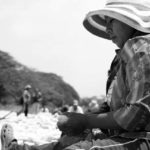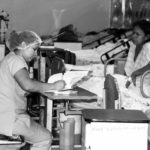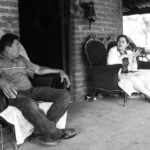“A hot, piercing pain ran through my bones. I couldn’t stretch my legs and got nauseated a lot. I took painkillers and used traditional medicine like leaf compresses on my legs. It wasn’t until they did the study that I found out I had renal damage.” Manuel Antonio Portillo, 46 years old, Las Brisas, San Miguel Department.
“They did a full check up in the hospital [as part of the study] and my results were all fine—except they discovered I have chronic kidney disease, stage 3. It’s not easy following all my doctor’s recommendations out here in the fields: our work is hard and our days long.” Roberto Reyes, 43 years old, Nueva Esperanza, Bajo Lempa region.
“I couldn’t walk my feet were so swollen and my legs were covered with lesions like little black beans. I was scared and didn’t want to do the study; my own mother scared me, saying the doctors would kill me. But without treatment it only gets worse; my life is much better now.” Wilfredo Ordoñez, 50 years old, Ciudad Romero, Bajo Lempa region.
These three stories come from the Salvadoran countryside, where chronic kidney disease (CKD) is taking its toll on universally poor farmworkers, their families and communities, as well as the health system. As early as 2004, people in the Bajo Lempa region, known as the country’s ‘breadbasket,’ were becoming aware of the problem. “The first health screenings were conducted at that time, and some fatalities were attributed to chronic kidney disease; this raised the alarm,” Dr Lilian Nuñez, Director of the Oscar Arnulfo Romero Specialized Community Family Health Unit (UCSF-E, its Spanish acronym) in Bajo Lempa, told MEDICC Review.
In 2009, a study of six communities in the area was launched to assess the scope of the disease and begin gathering scientific evidence to better understand its causes.[1] The study of 375 families dovetailed with the reorganization of the national health system in El Salvador and echoed reports in other parts of the world about CKD striking agricultural communities. The results from the Salvadoran study reflected what other researchers were finding: high CKD prevalence in patients not presenting diabetes mellitus or hypertension. Absence of these traditional causes in most people studied has led researchers to suggest that the disease is a new phenomenon: chronic kidney disease of uncertain etiology (CKDu).[2]
Extent & Nature of the Problem
According to WHO, from 2005 to 2009, more than 16,000 men in Central America died of renal failure. In Sri Lanka’s North Central Province, over 20,000 people have died from CKD in the past 20 years. This Sri Lankan agricultural region carries a particularly heavy CKD disease burden, with an estimated 400,000 people affected.[3] Similarly disquieting figures are emerging from farming communities in India, Nicaragua, Egypt, Costa Rica and elsewhere.[4] In January 2014, the issue turned deadly in Nicaragua’s sugar belt when protests against harsh working conditions erupted in violence; one protester was killed by police in that clash, hastening the need for reliable, actionable evidence of what is causing the disease, and for authorities to ensure workers’ health and safety.
High CKDu prevalence and mortality have sparked research by scientists from New Delhi to Boston. While more questions may be raised than answered at this point, the following is certain: the causes of this disease are different from CKD traditionally associated with diabetes or hypertension; most of the afflicted are men younger than 60 years old who work in agriculture under extraordinarily arduous conditions; and the disease is striking the poor at startling rates.
Although CKDu has been referred to as a ‘riddle’ or ‘mystery,’ it is likely caused by a set of risk factors including dehydration, heat stress and related disorders; self-medication with NSAIDs and medicinal plants; and the presence of naturally occurring heavy metals and artificially introduced chemical toxins in the soil, water, and air where these patients live and work. Genetics, alcohol consumption, fructose intake, and age of the patient may also play a role in such a multifactorial etiology.[5] Providing evidence to determine which of these risk factors, in isolation or combination, are primary, is driving current scientific research and debate.

Days are long, hot and hard in the cornfields of Nueva Esperanza, Bajo Lempa. / J Ochoa INS
Meanwhile, every day, farmworkers in stricken countries head to the fields to labor for long hours harvesting corn, cutting cane, planting rice, and fertilizing and fumigating crops under an infernal sun, without proper protection or even bathroom facilities. They often lack knowledge about prevention and, in too many places, access to the health services they need. Because CKD in early stages is asymptomatic, most who already have diminished kidney function do not know it. Meanwhile, others are falling ill. In two areas of El Salvador visited for this article, Usulután and San Miguel Departments, the mortality rates attributable to CKDu are 28.1 and 25.6 per 100,000 population respectively.[4]
Salvadoran Response to CKDu
El Salvador’s Ministry of Health and government have been pioneers in alerting the region and the world to CKDu, and in implementing both studies and services aimed at halting the epidemic. The total-population research undertaken in six communities in El Salvador’s Bajo Lempa region begun in 2009 (Nefrolempa study) was the proverbial pebble dropped into a lake: the study’s methodology and findings, policy implications, and response from the health system and community continue to ripple across the country and the region. Already, epidemiologists were monitoring chronic renal failure in the country, since it is the third cause of hospital deaths nationally. And El Salvador is the nation with the highest mortality attributable to kidney disease in the world—2500 deaths annually.[6] The Nefrolempa study revealed another stark reality: over 25% of men in that region suffer from CKD, with chronic renal failure affecting 9.8% of the overall population studied.[1,7]
From humble beginnings in a small house loaned to the research team (including medical students, Salvadoran nephrologists, family doctors, and PAHO advisors), the groundbreaking study sparked several reforms, innovations and actions including:
- Establishing nephrology services at the UCSF-E in Bajo Lempa, for later extension to other areas;
- Implementing a national renal health program at the primary care level for prevention, early detection, and treatment, particularly among vulnerable populations;
- Developing a national renal health research program;
- Writing clinical guidelines for treating CKD at all levels of the health system;
- Extending the study nationally;
- Actively involving community leaders, patients and their families in health promotion, education and advocacy;
- Spurring intersectoral research by toxicologists, geologists, and occupational and environmental health specialists to analyze potential risk factors;
- Providing a roadmap for other relevant, participatory research involving vulnerable populations;
- Regulating agricultural chemicals, pesticides and fertilizers, including proposals for tougher legislation; and
- Hosting the High-level Meeting on Chronic Kidney Disease of Non-Traditional Causes in Central America and adopting the San Salvador Declaration (2013).
Each of these initiatives aims to improve population health. For example, the renal health program at the primary level—an ambitious undertaking in its initial stages, complicated by the fact that there are only 32 nephrologists for this country of 6 million—foresees screening to reveal the extent of CKDu among farmworkers and their families, combined with followup treatment. This motivated researchers to extend the Bajo Lempa study to similar communities with different geographic and climatic conditions in an attempt to isolate possible risk factors. “This study helped us understand the scope of the disease; for instance, we learned that it wasn’t limited to the coastal zone,” says Dr José Manuel Pacheco, Director of San Juan de Dios National Hospital, San Miguel, where comprehensive testing, including renal biopsies, was conducted on 46 CKDu patients. “As these patients underwent testing, we also discovered that they had other health problems: cardiovascular, immunological, neurological, pulmonary, psychological. All these data are helping us design more effective responses. Clinically, we realized we had to approach the problem in an integral, holistic way.”
Reliable data on the extent and patterns of the disease are helping this hospital in San Miguel, El Salvador’s second-largest city, improve services, cut costs and better serve the public’s health. The study also helped equip and design the hospital’s new nephrology unit and provided “expert guidance for evaluating our entire CKD program,” says Dr Pacheco. By way of example, he cites the 150 patients currently in the ambulatory peritoneal dialysis program, an initiative allowing people needing this life-extending treatment to do it at home. “Prior to the study, only about 40 patients were doing at-home peritoneal dialysis, with most coming to the hospital and occupying beds instead. We realized the ambulatory model improves patients’ quality of life and also lowers the health system’s costs.”

The Nefrolempa study contributed to improved nephrology services at San Juan de Dios National Hospital. / J Ochoa INS
Patients eligible for this service receive two weeks of peritoneal dialysis and training at the hospital, accompanied by a family member, where they learn how to equip and maintain the area in their home set aside for dialysis; practice how to clean, sterilize, and manipulate abdominal catheters and other parts; participate in health promotion seminars on risk factors, diet, and behavior modification; and receive additional monitoring and treatment for other health problems—particularly chronic diseases.
Followup includes an initial home visit by the nephrology team to assess the ambulatory setup, and periodic visits thereafter, once home peritoneal dialysis begins. “It was a little intimidating and difficult to learn at first, but now I’ve got it down pat,” says Wilfredo Ordoñez, who has stage-5 CKD and has been in the ambulatory program since 2011. ‘Don Wil,’ as he’s known in the community, says the treatment has changed his life. “Every month the hospital gives me the supplies I need and I do dialysis at home. I feel good: I live a normal life, do errands, putter in the garden, play with my grandkids, and then do my dialysis,” says this lifelong farmworker in Bajo Lempa, now retired. Don Wil’s experience has encouraged others in the community to seek treatment—people who initially refused testing for fear of what might be found. “People see Don Wil and realize that CKD doesn’t have to be a death sentence; it can be treated and controlled,” says nephrologist Dr Juan Carlos Amaya, of the UCSF-E in Ciudad Romero. “If he hadn’t sought treatment when he did, he wouldn’t be here to tell his story,” Dr Amaya adds.
Role of Interdisciplinary Research
Ongoing collaborative studies by the Environmental and Occupational Health Research Unit and the Geologic Statistical Division of El Salvador’s National Health Institute, in cooperation with a team from Ohio University led by geologist Dr Dina L. López, are helping to discern what role soil and water quality may play in the epidemic. Providing an example of interdisciplinary research supported by the Ministries of Health and Environment, these complex studies test soil quality in the fields where patients work, their family plots and gardens, and surface and subterranean water in their communities. The testing measures presence of heavy metals, whether naturally occurring or introduced, and of agrochemicals. The researchers use Salvadoran standards for soil quality and Canadian for water quality. In Bajo Lempa, some subterranean water samples had “triple the amount of arsenic recommended by national standards and we’ve found elevated arsenic levels in the soil as well,” says Dr Alexandre Ribó, one of the geologists leading the research.

Evelyn Jackeline Fuentes explains dietary options to stage-2 CKD patient Victor Manuel Hernández, Las Brisas. / C. Gorry
Confirmational studies are under way testing soil and water for 32 pesticides, including DDT, a “complicated and sensitive process because we have to be sure our analysis is correct” before recommending policy actions. What these researchers can assert is that most farmworkers studied are handling highly toxic pesticides without proper protection. Noteworthy is the fact that Central America is the largest consumer, per inhabitant, of insecticides in Latin America.[8]
In San Luis Talpa and Las Brisas, two communities participating in the CKDu study beyond Bajo Lempa, residents and local health care providers are particularly keen to learn the results of water and soil testing: each of these settlements has a derelict agro-chemical warehouse where pesticides and fertilizers were mixed, diluted and stored until the 1980s. Manuel Antonio Portillo, who learned through the study that he has stage-3 CKD, lives near the crumbling walls and weed-infested lot of the abandoned warehouse. “Some people stored their drinking water in old barrels from over there,” Manuel Antonio says motioning towards the ruin. “They had nothing else, so they used the barrels.” His neighbor, Victor Manuel Hernández, also has stage-3 CKD. “I didn’t want to join the study, I had no symptoms and felt fine. But I was the one who ended up being sick,” he says from his yard, surrounded by his wife, children, and some frisky chickens, dogs and pigs.
Victor Manuel’s family are among 1342 people who were screened for the study. The diagnosis forced a change of lifestyle for the Hernández family, who work in agriculture: “we had to change our habits completely—the water we drank, how we stored our food. I had to give up alcohol, coffee, soda…Coffee was hard,” he says, looking away. “I miss coffee.”
Meeting the Challenges
A disease with such complex potential origins and cofactors is consuming scientists, policymakers, researchers, health professionals and administrators, as well as patients, as the search for solutions to this health problem—and how to finance the response—becomes more urgent. The first challenge, of course, is knowing the true burden of the disease, a considerable hurdle in most developing countries, where reliable CKD registries do not exist. Even in contexts where there is strong political will to implement epidemiological surveillance, efforts can be paralyzed by a lack of trained professionals to carry out the surveys; insufficient technological or methodological capacities; and skepticism or fear on the part of individuals or entire communities.
The hypothesis that water quality or agrochemicals may be implicated as CKDu cofactors or triggers is especially troubling to farmworkers in affected areas, and may increase their reticence to participate. “What to do? We have to use fertilizer and pesticides if we want a good harvest, we have to drink the water if we don’t want to die of thirst,” says a farmworker from Sri Lanka’s North Central Province,[9] voicing a common concern in this vulnerable group. Taking time off from work for the comprehensive testing required is also viewed as impractical by many farm laborers, who are often the heads of households. For these reasons, many do not seek treatment until advanced stages of the disease, and they die unable to afford life-saving dialysis or kidney transplant.[10]
In countries where the scope of the disease is better known, like El Salvador, the challenge becomes how to address and control the problem, provide treatment and followup, prevent new cases and conduct research—on a very limited budget. Putting accessible, affordable preventive and primary care services in place, as El Salvador is trying to do, is a necessary first step, but faces the same uphill battle as other underserved settings; the difficulties inherent in equipping and staffing remote health outposts. This scenario is playing out in Las Pilas, a high-altitude agricultural community near the Honduran border, where 128 patients were tested for CKDu. At over 2300 m (7500 feet) above sea level, the small farmers here cultivate cabbage, potatoes, melons, berries and other cool-weather crops on precipitous slopes. Under the health reforms, a UCSF-E was equipped and staffed in Las Pilas and included a nephrologist to provide treatment and followup for those patients diagnosed with CKD. That specialist relocated, however, and now the closest nephrology services are hours away via a steep mountain road, that can become impassable in the rainy season.
“Sometimes I have pain in my kidneys and headaches,” says 37-year-old Delmy Ruth Guillén, who learned she had stage-2 CKD in 2013. “We haven’t seen a specialist since we received our results and I’m not taking medicine or anything. It has me a bit anxious.” These feelings are shared by Rosa Yolanda Riviera, who worked alongside her father in these fields for many years as a child; the study found that she also has stage-2 CKD. “I have some pain. Not always, but it’s like a hot poker pressed against my back,” she says from her porch overlooking Las Pilas’ verdant fields. “I’m worried,” she adds.
Trekking from house-to-house visiting patients like Delmy and Rosa, Daisy Manzilla, a veteran health promoter from Las Pilas, seizes the opportunity to chat with families about the importance of pap smears, proper food preparation and good nutrition. “One of the challenges here is nutrition. We grow lots of fruits and vegetables, but people have really bad eating habits, preferring chips and soft drinks.” Daisy works tirelessly, walking miles every day, but the community is advocating for more and closer health services. “Things have improved,” says Daisy. “We used to have only a ‘health house’ here, open one day a week. Now we have a clinic, open and staffed five days a week, but our laboratory doesn’t have equipment or a technician.”
The complexities of providing care for patients identified in CKDu studies are also being felt in Las Brisas, site of another abandoned agrochemical warehouse. Says Evelyn Jackeline Fuentes, a physician with an MPH who has been working closely with this community for several years: “our mission is to improve the health and quality of life of these patients. But sometimes the medicine they need isn’t available and they can’t afford it without the health system subsidy; it pains me.” Still, her house calls on CKDu patients offer opportunities for lively, detailed discussions about water quality; proper storage of food and water; and diet.
“Some factors, like genetics, are out of our control. But we can help our patients modify detrimental habits and behaviors. Quitting drinking for example is beneficial for many reasons and these patients are now doing that.” Another problem beyond the control of health workers is the water supply. Evelyn points out that few homes here have potable water. Las Brisas waited 20 years for the pipes to be laid; now the pipes are in, but still must be connected to homes. “We have electricity, but no running or potable water. I buy half a dozen [five gallon] jugs of drinking water a week. It costs me about $40 a month,” says Victor Manuel Hernández, who is thinking about installing a filter.

Daisy Manzilla hikes through Las Pilas to visit patients. / C. Gorry
Hernández isn’t waiting for the scientific evidence to weigh in on water quality, but rather, is applying the precautionary principle—literally in his own back yard. This strategy involves mitigation of other possible risk factors, such as fructose intake, overuse of NSAIDs, and poor working conditions that can cause dehydration. Salvadoran leaders have applied the same principle, by proposing a law to ban imports of several toxic agrochemicals. Furthermore, alternatives to toxic pesticides and fertilizers are being piloted, literally from the ground up, in places like San Luis Talpa, the other rural community with a high incidence of CKDu and an abandoned agrochemical warehouse. There, an organic farm has been started as a community project to grow fruits and vegetables for local consumption; production from this project is slated to be scaled up for export, with help from international funders.[11]
Translating Research into Action
Providing the evidence base to tease out which of the many risk factors are most responsible for CKDu is a necessary and time-consuming scientific process. But the evidence is already in on one risk factor present in every patient studied from Nicaragua to India: they are all working poor. For these families, a sick member can mean the difference between eating and hunger, sleeping under a roof or the open sky, or being able to send children to school. This is especially true when the patient is the family’s main breadwinner, as with most CKDu cases. Thus, political will, exhibited through an intersectoral approach to address the social determinants lurking behind CKDu, is a critical component of any successful program to address the epidemic.
References

- Orantes CM, Herrera R, Almaguer M, Brizuela EG, Hernández CE, Bayarre H, et al. Chronic kidney disease and associated risk factors in the Bajo Lempa region of El Salvador: Nefromlempa study, 2009. MEDICC Rev. 2011 Oct;13(4):14–22.
- Researchers use different terms to categorize the epidemic, among them chronic kidney disease of non-traditional causes; chronic kidney disease of unknown origin/causes/etiology; Mesoamerican nephropathy (MeN); and chronic kidney disease in agricultural communities in Central America.
- Bandarage A. Killing Fields: Agrochemicals and Kidney Disease. Huffington Post [Internet]. New York: TheHuffingtonPost.com; 2013 Apr 26 [cited 2014 Apr 17]; [about 2 screens]. Available from: www.huffingtonpost.com/asoka-bandarage/agrochemicals-and-kidney-disease_b_3166002.html?
- Pan American Health Organization (personal communication); 2013 Apr 22.
- Cuadra SN, Jakobsson K, Hogstedt C, Wesseling C. Chronic kidney disease: Assessment of current knowledge and feasibility for regional research collaboration in Central America. Heredia (CR): SALTRA, IRET-UNA; 2006.
- Cohen J. Mesoamerica’s mystery killer. Science. 2014 Apr 11;344(6180):143–7.
- Ramírez-Rubio O, McClean MD, Amador JJ, Brooks DR. An epidemic of chronic kidney disease in Central America: an overview. J Epidemiol Community Health [Internet]. 2013 Jan [cited 2014 Apr 17 ];67(1):1–3. Available from: http://jech.bmj.com/content/67/1/1.long
- Quinteros ER, Mejía JR, López JA, Ribó A. Riesgos toxicoambientales y ocupacionales: Resultados preliminares de la experiencia en Bajo Lempa, Usulután. San Salvador: National Institute of Health (SV); 2013 Jun. Spanish.
- Perera A. Study links kidney disease in Sri Lanka’s farm belt to agrochemicals. IPS News [Internet]. Rome: Inter Press Service; 2012 Aug 21 [cited 2014 Apr 17]. Available from: www.ipsnews.net/2012/08/study-links-kidney-disease-in-sri-lankas-farm-belt-to-agrochemicals.
- Wesseling C, Crowe J, Hogstedt C, Jakobsson K, Lucas R, Wegman DH. The epidemic of chronic kidney disease of unknown etiology in Mesoamerica: a call for interdisciplinary research and action. Am J Public Health. 2013 Nov;103(11):1927–30.







